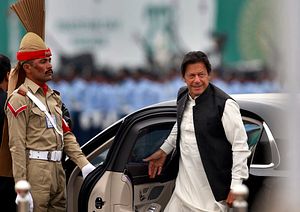After years of campaigning as the figurehead of a minor party on Pakistan’s political sidelines, Pakistani cricket star and philanthropist Imran Khan’s efforts to bring about a “New Pakistan” culminated in victory. Having split the opposition vote to little effect in the previous elections of 2013, in the July 2018 national elections Khan led his Pakistan Tehreek-e-Insaf (PTI) party to beat out weakened rivals and form a government at the national level, as well as in two of the country’s four provincial assemblies.
Achieving this electoral victory required Khan to make numerous compromises on the path to power, including accommodations with the country’s military establishment and other political elites who now support his premiership. Though Khan’s populist convictions and commitment to pursuing an anti-corruption drive against his now-vanquished political rivals appear to be unshaken, his first year in office has been a difficult one, with more challenges and compromises yet to come.
The PTI’s Path to Victory
Once a marginal player with little in the way of a support base outside of his own considerable national celebrity, Khan first rose to head a broader political movement in the run-up to the 2013 elections. He drew large crowds of supporters — particularly among the urban middle class elites and urban youth — and campaigned on a vaguely defined but resonant message of transformational “change.” In the political heartland of Punjab province, PTI candidates split the 2013 vote in threeway contests with the then-incumbent Pakistan Peoples Party (PPP) and the Pakistan Muslim League-Nawaz (PML-N), but in most cases failed to secure pluralities, leaving the party with few elected representatives outside of Khyber Paktunkhwa province, where it was able to form a government.
With little representation afforded to it through the formal democratic system, the PTI was swift to dispute its losses through both the legal system and through extralegal street protests that paralyzed the capital city of Islamabad for several months in 2013-2014. Contemporaneous and subsequent reporting has suggested that the Pakistani military establishment, whose relations with the PML-N government of three-time Prime Minister Nawaz Sharif were tense from the start, and which has a long history of both direct and indirect intervention in the country’s politics, was a behind-the-scenes booster of the PTI demonstrations. Those protests helped underscore the PTI’s role as the major national opposition force, regardless of the number of seats it held in parliament.
Although the PTI’s 2018 electoral victory was narrower than the two governments that had preceded it – its candidates won by smaller margins, and it fell short of an absolute majority in parliament, leaving its coalition reliant on smaller parties to serve as partners – it nonetheless emerged as the broadest-reaching of the three major national parties, claiming a mandate to enact Imran Khan’s populist vision for Naya Pakistan, or “New Pakistan.”
































